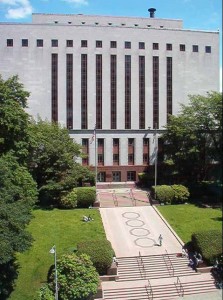
Historic Nakamura Courthouse in Seattle has received LEED Silver in both LEED NC and LEED EB:O&M. It’s also the first LEED project I worked on almost ten years ago.
When I first began working on LEED projects and applying LEED and sustainable building practices to historic buildings, I always used to hear, “historic buildings can’t get LEED,” or “historic buildings? Those old energy hogs, they can’t be green!” Well I hear those comments less and less now, and having lists like the one that USGBC just posted today of the many historic buildings that have achieved LEED, makes my job easier and easier. I was particularly thrilled to see the Nakamura Courthouse listed for achieving LEED Silver NC AND EB, as that was the first LEED project I worked on when I was the Regional Historic Preservation Officer for GSA in Seattle.
Does It Have to Be LEED Certified To Be Green?
That’s another question I get asked all the time. No, of course, you can “green” a building without registering for LEED certification. The benefits of LEED certification are both implicit and explicit. It is the most recognized green rating system in the world and as such, LEED certification suggests a marketing and public relations cachet, which no other system yet achieves, while indicating to the public that the owner and building is environmentally and socially conscious. In addition, the ongoing operations of the building should be significantly more efficient depending on the LEED credits achieved. Using the LEED process and system is the most readily recognized green rating system in the world, and as such most manufacturers have aligned their product material with the LEED credits.

Both the Empire State Building and the Chrysler Building have achieved LEED Gold under LEED EB: Operations & Maintenance which is one of the reasons why they are considered “greener” than the new LEED Platinum Bank of America tower.
It is key to acknowledge though, that no matter how good the design intentions are, the actual efficiency of a building can only be really understood and controlled during the operations of the building, after it has received its LEED NC or Core & Shell or Homes etc certification. I always tell people that the most significant energy and resource use is during the operations of the building (almost 75%) and NOT during its one-point-in-time construction project. The proof is in the pudding, as they say. And this has made big news this week with the data that has come out about the energy use at the Bank of America tower in Manhattan. While I’ve been using this article to show people that the historic Empire State Building is more efficient than the new platinum BOA tower, that is a little disingenuous. The Empire State Building received LEED Gold in 2011 under LEED EB and scores better in Energy Star and the NYC benchmarking than BOA because they’re managing their operations better. I don’t know who is overseeing sustainability and public relations for BOA, but they’re not doing a very good job. First, you should sign up for LEED EB as part of your construction project. Well before your construction is finished and your building opens, start planning your maintenance program and register for LEED EB. Maybe they have, I don’t know, but they’re not spinning it properly then if they have. The whole point of LEED EB is to ensure your building is operating the way you designed it, and tweaking and refining it when you see it isn’t.

The historic Christman Building in
Lansing, Michigan was the first building in the world to achieve triple LEED platinum. Photo courtesy the Christman Company.
My favorite LEED story is the one about the Christman Building in Lansing, Michigan. This renovation project of a historic building was the first building in the world to achieve triple LEED certification – LEED Core & Shell, Commercial Interiors and EB. And here is where the system and process worked properly. After their first year in operation, as they were preparing to submit for LEED EB they discovered that their Energy Star rating was horrific – and they spent a year evaluating the issues and making improvements. They went from “impossible to even be eligible for LEED EB” to platinum! LEED EB is a cyclical maintenance plan on steroids.
So the moral of the story is that YES, any building, old, historic or new can achieve LEED certification. But ensuring that its design intent is actually being implemented can only be achieved by monitoring and controlling the “low efficiency” systems and processes. If your goal is to get a plaque to put on the wall and that’s it, then a LEED capital rating system like LEED NC, Core & Shell, Homes, etc is your objective. Sure get your LEED NC plaque but don’t stop there. If you really want to manage your energy and resource use AND really help save the planet, then LEED Existing Buildings: Operations & Maintenance is the way to go. Bank of America, I’m waiting for your call.
And if you’d like to “subscribe” or follow my blog, True Green Cities, please sign up through the “Subscribe” button at the bottom left of this page. You’ll receive a daily recap when new blogs are posted. Or Sign up for the Feed.
